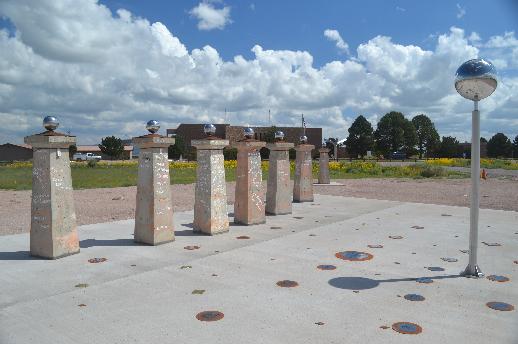25 September 2013
Contact:
Dave Finley, Public Information Officer
Socorro, NM
(575) 835-7302
dfinley@nrao.edu
VLA Open House Features Premiere of Movie Narrated by Jodie Foster,
Public Opening of Unique, Walk-Through Sundial
The National Radio Astronomy Observatory (NRAO) will host a public open house at the Karl G. Jansky Very Large Array (VLA) on Saturday, October 5. In addition to free, guided public tours, the event will feature the premiere of a new radio astronomy movie narrated by Jodie Foster, and the public debut of an impressive new sundial unlike any other in the world.
The festivities start with the movie premiere at 11:00 a.m., and the guided tours start at noon and run until 4:00 p.m. The VLA is 50 miles west of Socorro on U.S. Highway 60. All events are free and no reservations are required.

CREDIT: NRAO/AUI/NSF |
The new, high-definition movie, entitled, Beyond the Visible: The Story of the Very Large Array, will replace the existing movie at the VLA Visitor Center. The film is narrated by Jodie Foster, star of the 1997 Warner Brothers film, Contact, which was filmed in part at the VLA. Foster spent several days at the VLA in 1996 during the Contact filming.
"In Contact, I played the role of an astronomer using the VLA. In narrating this new film for the VLA Visitor Center, I have the privilege of introducing tomorrow's scientists, technicians, and engineers to the amazing complexities of this great telescope, and to the wonders of the Universe that it reveals," Foster said.
Beyond the Visible tells the behind-the-scenes story of the operation and scientific achievements of the VLA, which has been at the forefront of astrophysical research since its dedication in 1980. With spectacular ground and aerial footage of the iconic radio telescope, the movie depicts many of the unsung heroes of the NRAO's technical staff who keep the telescope working and scientists who use it to discover exciting new facts about the Universe.
"Since the last film for the Visitor Center was produced in 2002, we've completed a massive technological upgrade that turned the VLA into a completely new and vastly more powerful tool for cutting-edge science," said Dale Frail, NRAO's Director for New Mexico Operations. "It was time to update the story we tell our visitors," he added.
The new film was shot on location under the supervision of Director Nils Cowan of Hemlock Productions in Seattle, and edited by Joanne Ardinger. NRAO's Assistant Director for Education and Public Outreach, John Stoke, served as Executive Producer.
The open house event also will be the first official public viewing for a new, unique, walk-through sundial that uses historical scientific artifacts to combine traditional timekeeping features with functions illustrating the history and accomplishments of radio astronomy.
Named for pioneering radio astronomer Ronald Bracewell, the sundial incorporates concrete piers that originally held dish antennas for a California radio observatory Bracewell built and operated for two decades starting in the 1960s. Bracewell used the piers as a novel "guest book," handing visiting astronomers a hammer and chisel to carve their signatures into the concrete. He accumulated more than 200 of these signatures from many of the leading pioneers of radio astronomy, observatory directors from around the world, and two Nobel Prize recipients.
Bracewell's observatory was abandoned in 1980. In 2012, donations from the Friends of the Bracewell Observatory Association, Associated Universities, Inc., and the National Science Foundation made it possible to saw off ten of the concrete piers and transport them to the VLA. The piers, with their signatures, now are an integral part of the new sundial.
The central portion of the sundial is on a 46-by-35-foot concrete slab. Markers that indicate the time of day are embedded in the slab, where the shadow of a metal sphere mounted atop a post can fall on them. Visitors can walk around the sundial to find not only the time of day but the approximate time of the year. Other markers indicate important dates in the history of radio astronomy, and solar noon at other observatories.
Unlike any other sundial, this one, designed by Woody Sullivan of the University of Washington, allows visitors to locate the approximate position in the sky of three celestial objects that played important roles in radio astronomy -- two distant galaxies and the remains of an exploded star in our own Milky Way.
"Our sundial is unique in the world. It incorporates the history of radio astronomy into an impressive and beautiful natural timepiece, and has features unmatched by any other sundial," said Miller Goss, who led the NRAO project to build it.
The sundial is a tribute to Bracewell, who himself designed several sundials before his death in 2007. An Australian native who received a Ph.D from Cambridge University and worked on radar during World War II, Bracewell developed many of the mathematical techniques used today to make images with the VLA and other radio telescopes. From 1955 on, he was a professor at Stanford, and, among other contributions, helped adapt radio-astronomy techniques to make CAT scans possible.
The National Radio Astronomy Observatory is a facility of the National Science Foundation, operated under cooperative agreement by Associated Universities, Inc.
